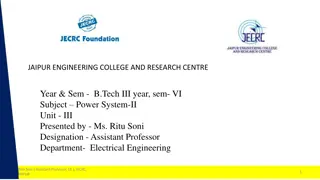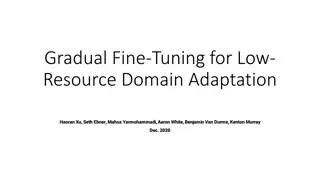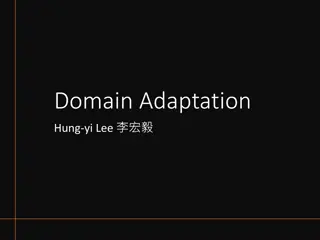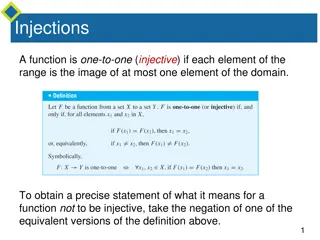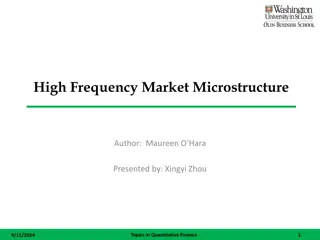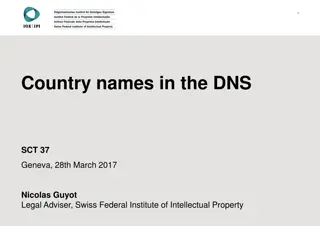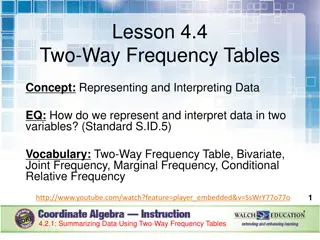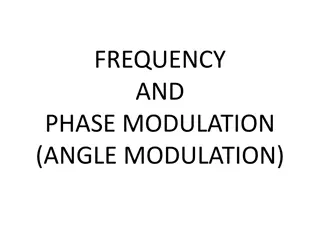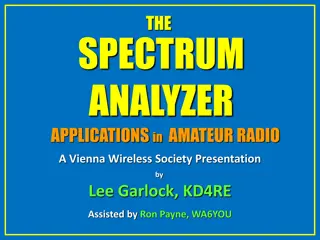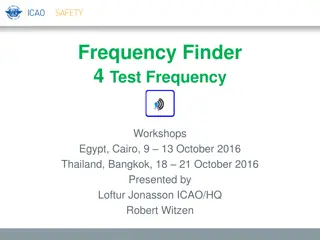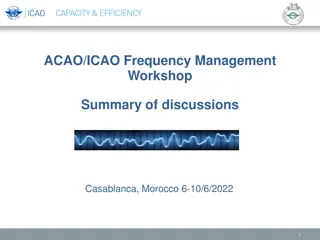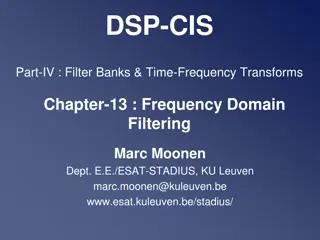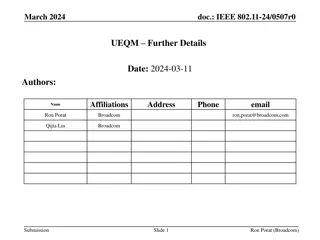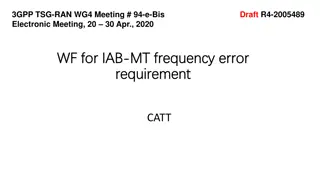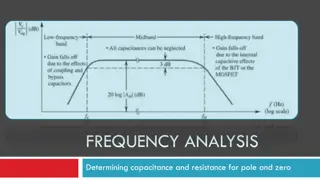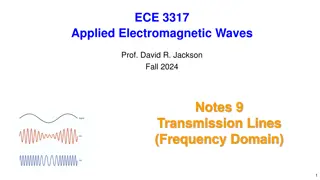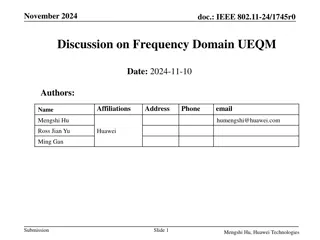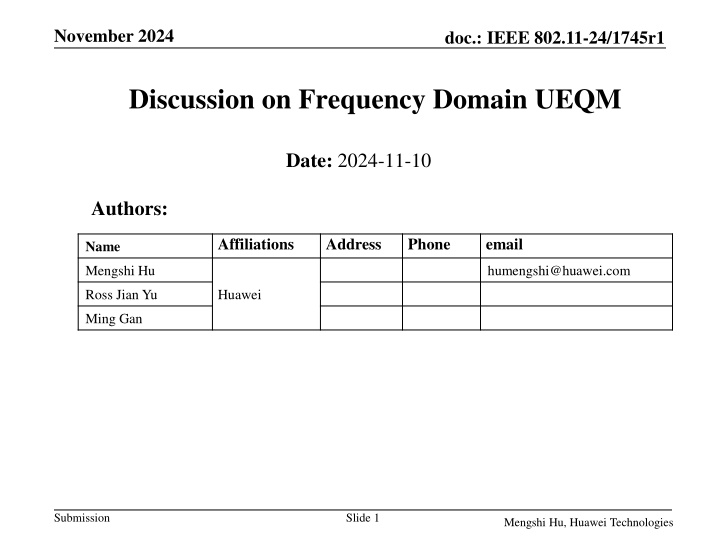
Discussion on Frequency Domain UEQM in IEEE 802.11-24/1745r1 Document
Explore the discussion on Frequency Domain UEQM in the IEEE 802.11-24/1745r1 document, focusing on unequally applying modulations to subcarriers for enhanced performance in wireless communications. The document delves into simulation results, benefits, configuration setups, and interference considerations related to Frequency Domain UEQM.
Download Presentation

Please find below an Image/Link to download the presentation.
The content on the website is provided AS IS for your information and personal use only. It may not be sold, licensed, or shared on other websites without obtaining consent from the author. If you encounter any issues during the download, it is possible that the publisher has removed the file from their server.
You are allowed to download the files provided on this website for personal or commercial use, subject to the condition that they are used lawfully. All files are the property of their respective owners.
The content on the website is provided AS IS for your information and personal use only. It may not be sold, licensed, or shared on other websites without obtaining consent from the author.
E N D
Presentation Transcript
November 2024 doc.: IEEE 802.11-24/1745r1 Discussion on Frequency Domain UEQM Date: 2024-11-10 Authors: Affiliations Address Phone email Name Mengshi Hu humengshi@huawei.com Ross Jian Yu Huawei Ming Gan Submission Slide 1 Mengshi Hu, Huawei Technologies
November 2024 doc.: IEEE 802.11-24/1745r1 Background UEQM (Unequal Modulation) is a promising feature enabling different modulation orders in the resource allocated to a user. It could provide obvious gains when there exists a large SNR difference [1]. In general, there are mainly two kinds of UEQM [2]: Spatial domain UEQM (Different modulations are applied to different spatial streams) Frequency domain UEQM (Different modulations are applied to different subcarriers) The spatial domain UEQM has been adopted in UHR, while the frequency domain UEQM is still under discussion. Define unequal modulation over different spatial streams (Motion 23) In this contribution, the performance of the frequency domain UEQM is further discussed. This is a follow-up contribution of Reference [3]. Submission Slide 2 Mengshi Hu, Huawei Technologies
November 2024 doc.: IEEE 802.11-24/1745r1 Frequency Domain UEQM Regarding the frequency domain UEQM, some related simulation results and benefits are mentioned in [2]. Take advantage of the channel selective gains. Good for the interference case where some of the subcarriers suffer from a relatively strong interference. A strong interference Resource allocated to a user Subcarriers suffering from this interference Fig. 1 A use case of frequency UEQM Submission Slide 3 Mengshi Hu, Huawei Technologies
November 2024 doc.: IEEE 802.11-24/1745r1 Simulation Configuration To find the benefits using frequency domain UEQM, the following simulation configurations are used. Table. 1 Simulation Configuration Item Configuration PPDU BW 40 MHz Channel Mode & Estimation Channel D & Realistic & Smoothing RU 484-tone RU with 468 data subcarriers Frequency Domain UEQM The left 234 subcarriers correspond to Modulation A; The right 234 subcarriers correspond to Modulation B; One PSDU & Same Coding Rate Length 1200 Bytes Data Encoding LDPC (Joint Coding) Transmission Single User & One Spatial Stream Interference Add additional interference to the right half of the 484-tone RU Left 234 data subcarriers (Modulation A) Fig. 2 A 484-tone RU with frequency domain UEQM Right 234 data subcarriers (Modulation B) Submission Slide 4 Mengshi Hu, Huawei Technologies
November 2024 doc.: IEEE 802.11-24/1745r1 Adding Interference To establish a environment that some of the subcarriers are affecting by a narrow band interference, we have the following modifications: Add a narrow band interference to the noise in the time domain. To clearly show the power difference in the following figures, the noise power is normalized to 1 (0 dB). The left half subcarriers of the RU are affected by the noise, while the right half subcarriers of the RU are affected both by the noise and interference. Noise on 512 Subcarriers + Additional 6 dB Interference on the Right Side Noise on 512 Subcarriers + Additional 18 dB Interference on the Right Side 30 20 20 10 Normalized Power (dB) Normalized Power (dB) 10 0 0 -10 -10 -20 -20 -30 -30 -40 0 100 200 300 400 500 0 100 200 300 400 500 Subcarrier Index (from 1 to 512) Subcarrier Index (from 1 to 512) Fig. 4 Examples of add interference (6 dB & 18 dB) Submission Slide 5 Mengshi Hu, Huawei Technologies
November 2024 doc.: IEEE 802.11-24/1745r1 Simulation Clarification To clearly show the performance of EQM and UEQM, the PER and Goodput are used to analyze it. The the following equation is used for the goodput calculation: ??????? = 1 ??? ?????/??????????????? The SNR values shown in the results later indicate the signal-to-noise ratio without considering the interference. The following cases of interference are simulated: 6 dB interference compared to the noise 12 dB interference compared to the noise Submission Slide 6 Mengshi Hu, Huawei Technologies
November 2024 doc.: IEEE 802.11-24/1745r1 Simulation Result A (6 dB interference) The following goodput result considers a 6 dB interference The three UEQM schemes shown by solid curves below all provide additional gains at some SNRs. Interference: 6 dB compared to noise 120 4, 4, 1/2 (MCS 1) 4, 4, 3/4 (MCS 2) 16, 4, 1/2 16, 4, 3/4 16, 16, 1/2 (MCS 3) 16, 16, 3/4 (MCS 4) 64, 16, 3/4 64, 64, 2/3 (MCS 5) 100 80 Note: The above three values indicate Modulation Order A, Modulation Order B, and Coding Rate, respectively. Goodput (Mbps) 60 20% gain at this point 40 20 0 0 5 10 15 20 25 30 SNR (dB) Submission Slide 7 Mengshi Hu, Huawei Technologies
November 2024 doc.: IEEE 802.11-24/1745r1 Simulation Result B (12 dB interference) The following goodput result considers a 12 dB interference All the curves have a right shift of several decibels, compared to the case of 12 dB interference. In addition, the gains provided by the frequency domain UEQM become more obvious. Interference: 12 dB compared to noise 120 4 4 1/2 (MCS 1) 4 4 3/4 (MCS 2) 16 4 1/2 16 4 3/4 16 16 1/2 (MCS 3) 16 16 3/4 (MCS 4) 64 16 3/4 64 64 2/3 (MCS 5) 100 80 Note: The above three values indicate Modulation Order A, Modulation Order B, and Coding Rate, respectively. Goodput (Mbps) 60 39% gain at this point 40 20 0 10 15 20 SNR (dB) 25 30 Submission Slide 8 Mengshi Hu, Huawei Technologies
November 2024 doc.: IEEE 802.11-24/1745r1 Conclusion In this contribution, the frequency domain UEQM was discussed. The performance of frequency domain UEQM was shown. Some different interference levels were investigated in the simulations. Simulation results showed that the frequency domain UEQM provides obvious gains if there exists obvious SINR gaps at different frequencies. For example, a 39% gain could be seen at the SNR of 20 dB in the case of a 12 dB interference added to the right part of the 484-tone RU. Suggest enabling frequency domain UEQM for the interference case. Submission Slide 9 Mengshi Hu, Huawei Technologies
November 2024 doc.: IEEE 802.11-24/1745r1 References [2] 11-24-0438-00-00bn-ueqm-benefit-analysis [1] 11-24-0433-00-00bn-analysis-on-ueqm-and-ueq-mcs [3] 11-24-1132-01-00bn-frequency-domain-ueqm Submission Slide 10 Mengshi Hu, Huawei Technologies

